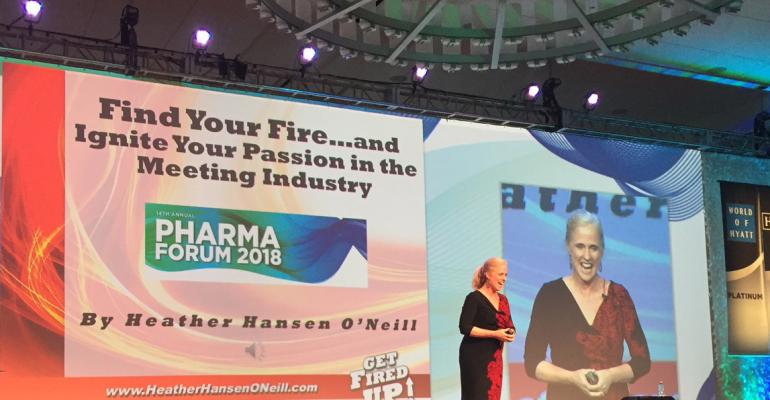By the third and final day of the 2018 Pharma Forum, which MeetingsNet co-organizes with CBI, the late nights, early mornings, and full days had somewhat banked my inner fire, I have to admit. I knew we had a good, high-energy lineup to bring it all home, but I hadn't quite appreciated just how high-energy until Heather Hanson O’Neill took the stage. The speaker, author, adventurer, entrepreneur, and philanthropist was a force of nature. No wonder her company is called Find Your Fire—she knew how to fire up this crowd of life sciences corporate and third-party meeting professionals, and hospitality and other vendors, along with the odd journalist or two.
She obviously practices what she preaches—and she also obviously has a thing for heights, with examples of things she’s learned from rock climbing and trapeze flying, among other things that cause many in the audience to have some high anxiety just thinking about. But she pulled great lessons from each experience. Like when, on the advice of the person holding her safety line, she tried to reach a handhold while 150 feet up a cliff—and missed. He kept her from falling, and she ended up in a better place with handholds that let her make it to the top.
“Surround yourself with people who say, “You can do this, I got you,” she said. “When you fall—and you will—look around for handholds that will help you get where you want to go faster and better.”
She also told us how to MAP our way to better relationships with our work, our colleagues, and just about anything else.
M is for mindset. She put this Michael Jordan quote on the screen: “Limits, like fears, are often just an illusion.” Our mental approach makes all the difference. She also challenged us to think of someone who has made a difference in our lives, and commit to send them a thank-you note. “Nothing lights that inner flame more than gratitude.”
A is for adaptability. Planners have to be detail-oriented and analytical, she said, but they also have to be creative—and be able to sell others on their ideas. Some people, like Hanson O’Neill, thrive on change. Others, not so much, even if the change is positive. The key is to figure out where the people you deal with are on the change spectrum. For those who are resistant to change, it helps to show the positives that can come out of it, she said. And while change can be uncomfortable, that’s OK. She likened it to building muscle, where you have to be uncomfortable to make progress.
P is for plan of action. Start building your plan by thinking about the direction you want to go in, she said. What do you want to do? Where do you want to go? Then look at the why—why will this action make you a better planner? Once you have the where and the why, then you can get to the how—how will you make it happen? Yes, you’ll hit barriers along the way, and some will be outside of your control, such as the regulations that govern meetings this crowd plans for healthcare professionals. But put your focus on what you can control, she said.
“You get to choose what you think and feel, and where you put your focus.”
As she wrapped up her presentation, she had us each write down something that’s holding us back, something that our inner voice likes to harp on that probably isn’t even true. A few people read theirs out loud—I stood, faced the audience, and told them mine, which was, “I will literally pass out if I have to stand, face a big crowd, and speak”—and then we all shredded our bad self-talk notes and tossed them in the air.
It was freeing. It was empowering. It was a good reminder that, as she found out when learning to fly on a trapeze, sometimes you have to let go before you can fly.





